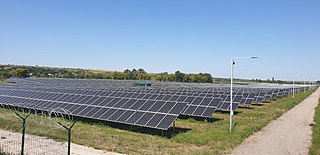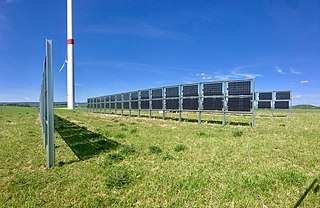
Photovoltaics (PV) is the conversion of light into electricity using semiconducting materials that exhibit the photovoltaic effect, a phenomenon studied in physics, photochemistry, and electrochemistry. The photovoltaic effect is commercially used for electricity generation and as photosensors.
An epitaxial wafer is a wafer of semiconducting material made by epitaxial growth (epitaxy) for use in photonics, microelectronics, spintronics, or photovoltaics. The epi layer may be the same material as the substrate, typically monocrystaline silicon, or it may be a silicon dioxide (SoI) or a more exotic material with specific desirable qualities. The purpose of epitaxy is to perfect the crystal structure over the bare substrate below and improve the wafer surface's electrical characteristics, making it suitable for highly complex microprocessors and memory devices.

A solar cell or photovoltaic cell is an electronic device that converts the energy of light directly into electricity by means of the photovoltaic effect. It is a form of photoelectric cell, a device whose electrical characteristics vary when it is exposed to light. Individual solar cell devices are often the electrical building blocks of photovoltaic modules, known colloquially as "solar panels". Almost all commercial PV cells consist of crystalline silicon, with a market share of 95%. Cadmium telluride thin-film solar cells account for the remainder. The common single-junction silicon solar cell can produce a maximum open-circuit voltage of approximately 0.5 to 0.6 volts.

A solar panel is a device that converts sunlight into electricity by using photovoltaic (PV) cells. PV cells are made of materials that produce excited electrons when exposed to light. The electrons flow through a circuit and produce direct current (DC) electricity, which can be used to power various devices or be stored in batteries. Solar panels are also known as solar cell panels, solar electric panels, or PV modules.
A photovoltaic system, also called a PV system or solar power system, is an electric power system designed to supply usable solar power by means of photovoltaics. It consists of an arrangement of several components, including solar panels to absorb and convert sunlight into electricity, a solar inverter to convert the output from direct to alternating current, as well as mounting, cabling, and other electrical accessories to set up a working system. Many utility-scale PV systems use tracking systems that follow the sun's daily path across the sky to generate more electricity than fixed-mounted systems.

Cadmium telluride (CdTe) photovoltaics is a photovoltaic (PV) technology based on the use of cadmium telluride in a thin semiconductor layer designed to absorb and convert sunlight into electricity. Cadmium telluride PV is the only thin film technology with lower costs than conventional solar cells made of crystalline silicon in multi-kilowatt systems.
Narec, since 2014 known as the National Renewable Energy Centre, is a part of the Offshore Renewable Energy (ORE) Catapult, a British technology innovation and research centre for offshore wind power, wave energy, tidal energy and low carbon technologies. ORE Catapult's head office is in Glasgow, Scotland. The centre operates multi-purpose offshore renewable energy test and demonstration facilities. It is similar to other centres, such as NREL in the US and National Centre for Renewable Energies (CENER) in Spain. The National Renewable Energy Centre is based in Blyth, Northumberland.

Crystalline silicon or (c-Si) is the crystalline forms of silicon, either polycrystalline silicon, or monocrystalline silicon. Crystalline silicon is the dominant semiconducting material used in photovoltaic technology for the production of solar cells. These cells are assembled into solar panels as part of a photovoltaic system to generate solar power from sunlight.

Jerry M. Woodall is a professor of electrical and computer engineering at the University of California, Davis who is widely known for his revolutionary work on LEDs and semiconductors. Over the course of his career, he has published close to 400 scientific articles and his work has directly contributed to the development of major technologies that are used around the world, such as TVs, optical fibers, and mobile phones. Woodall currently holds over 80 U.S. patents for a variety of inventions and has received prestigious awards from IBM, NASA, and the U.S. President for his contributions to science, technology, and humanity.
Potential-induced degradation (PID) is a potential-induced performance degradation in crystalline photovoltaic modules, caused by so-called stray currents. This effect may cause power loss of up to 30 percent.
Light soaking refers to the change in power output of solar cells which can be measured after illumination. This can either be an increase or decrease, depending on the type of solar cell. The cause of this effect and the consequences on efficiency varies per type of solar cell. Light soaking can generally cause either metastable electrical or structural effects. Electrical effects can vary the efficiency depending on illumination, electrical bias and temperature, where structural effects actually changes the structure of the material and performance is often permanently altered.

At the time of commissioning in 2003, the 500 kW Chevron Solarmine solar photovoltaic (PV) system was the world's largest thin-film amorphous silicon solar PV system and one of the largest solar PV systems in the United States. Located at the Midway-Sunset Oil Field, Solarmine was the first solar PV system in California to power oil field operations.

Multiple different photovoltaic module analysis techniques are available and necessary for the inspection of photovoltaic (PV) modules, the detection of occurring degradation and the analysis of cell properties.

A bifacial solar cell (BSC) is any photovoltaic solar cell that can produce electrical energy when illuminated on either of its surfaces, front or rear. In contrast, monofacial solar cells produce electrical energy only when photons impinge on their front side. Bifacial solar cells can make use of albedo radiation, which is useful for applications where a lot of light is reflected on surfaces such as roofs. The concept was introduced as a means of increasing the energy output in solar cells. Efficiency of solar cells, defined as the ratio of incident luminous power to generated electrical power under one or several suns (1 sun = 1000W/m2 ), is measured independently for the front and rear surfaces for bifacial solar cells. The bifaciality factor (%) is defined as the ratio of rear efficiency in relation to the front efficiency subject to the same irradiance.
Soiling is the accumulation of material on light-collecting surfaces in solar power systems. The accumulated material blocks or scatters incident light, which leads to a loss in power output. Typical soiling materials include mineral dust, bird droppings, fungi, lichen, pollen, engine exhaust, and agricultural emissions. Soiling affects conventional photovoltaic systems, concentrated photovoltaics, and concentrated solar (thermal) power. However, the consequences of soiling are higher for concentrating systems than for non-concentrating systems. Note that soiling refers to both the process of accumulation and the accumulated material itself.

pvlib python is open source software for simulating solar power of photovoltaic energy systems.

Heterojunction solar cells (HJT), variously known as Silicon heterojunctions (SHJ) or Heterojunction with Intrinsic Thin Layer (HIT), are a family of photovoltaic cell technologies based on a heterojunction formed between semiconductors with dissimilar band gaps. They are a hybrid technology, combining aspects of conventional crystalline solar cells with thin-film solar cells.

The European Photovoltaic Solar Energy Conference and Exhibition is an international scientific conference and industry exhibition in the solar energy industry. The event covers developments in different aspects of photovoltaics, including science, technology, systems, finance, policies, and markets. The conference topics include the spectrum of photovoltaics value chain, such as policy considerations and foundational aspects.
The World Conference on Photovoltaic Energy Conversion (WCPEC) is an international scientific conference in the solar energy industry, combining three international PV conferences: the EU PVSEC on the European side, IEEE PVSC on the USA side, and PVSEC on the Asia-Pacific side. The event covers developments in different aspects of photovoltaics, including science, technology, systems, finance, policies, and markets. The conference programme of the European segment is coordinated by the European Commission's Joint Research Centre (JRC).











